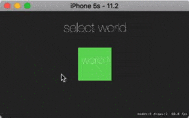有许多方法可以获得它,通过 SKCameraNode,使用像 UIScrollView 这样的 UIKit 元素或其他方式...
但我想向您展示如何仅使用 SpriteKit 简单地完成。
从概念上讲,您应该构建一个更大的 SKNode,其中包含菜单的每个单独声音,每个元素之间距离相等。
您可以使用一个 SKAction 来模拟滚动,将我们的节点移动到最近可见元素的中心。
GameViewController:
class GameViewController: UIViewController {
override func viewDidLoad() {
super.viewDidLoad()
guard let view = self.view as! SKView? else { return }
view.ignoresSiblingOrder = true
view.showsFPS = true
view.showsNodeCount = true
view.showsPhysics = false
view.showsDrawCount = true
let scene = GameScene(size:view.bounds.size)
scene.scaleMode = .aspectFill
view.presentScene(scene)
}
}
GameScene:
class GameScene: SKScene {
var lastX: CGFloat = 0.0
var moveableArea = SKNode()
var worlds: [String]! = ["world1","world2","world3"]
var currentWorld:Int = 0
var worldsPos = [CGPoint]()
override func didMove(to view: SKView) {
let topLabel = SKLabelNode.init(text: "select world")
topLabel.fontSize = 40.0
self.addChild(topLabel)
topLabel.zPosition = 1
topLabel.position = CGPoint(x:frame.width / 2, y:frame.height*0.80)
self.addChild(moveableArea)
moveableArea.position = CGPoint(x:self.frame.midX,y:self.frame.midY)
for i in 0..<worlds.count {
let worldLabel = SKLabelNode.init(text: worlds[i])
self.moveableArea.addChild(worldLabel)
worldLabel.position = CGPoint(x:CGFloat(i)*self.frame.width ,y:moveableArea.frame.height*0.60)
let randomRed = CGFloat(drand48())
let randomGreen = CGFloat(drand48())
let randomBlue = CGFloat(drand48())
let randomColor = UIColor(red: randomRed, green: randomGreen, blue: randomBlue, alpha: 1.0)
let worldSprite = SKSpriteNode.init(color: randomColor, size: CGSize.init(width: 100.0, height: 100.0))
worldSprite.name = worlds[i]
self.moveableArea.addChild(worldSprite)
worldSprite.position = CGPoint(x:CGFloat(i)*self.frame.width ,y:0.0)
}
}
func tapNode(node:SKNode,action:SKAction) {
if node.action(forKey: "tap") == nil {
node.run(action, withKey: "tap")
}
}
override func touchesBegan(_ touches: Set<UITouch>, with event: UIEvent?) {
let touch = touches.first!
let location = touch.location(in: self)
let touchedNode = self.atPoint(location)
lastX = location.x
let sequence = SKAction.sequence([SKAction.scale(to: 1.5, duration: 0.2),SKAction.scale(to: 1.0, duration: 0.1)])
switch touchedNode.name {
case "world1"?:
print("world1 was touched..")
tapNode(node:touchedNode,action:sequence)
case "world2"?:
print("world2 was touched..")
tapNode(node:touchedNode,action:sequence)
case "world3"?:
print("world3 was touched..")
tapNode(node:touchedNode,action:sequence)
default:break
}
}
override func touchesMoved(_ touches: Set<UITouch>, with event: UIEvent?) {
let touch = touches.first!
let location = touch.location(in: self)
let currentX = location.x
let leftLimit:CGFloat = CGFloat(worlds.count-1)
let rightLimit:CGFloat = 1.0
let scrollSpeed:CGFloat = 1.0
let newX = moveableArea.position.x + ((currentX - lastX)*scrollSpeed)
if newX < self.size.width*(-leftLimit) {
moveableArea.position = CGPoint(x:self.size.width*(-leftLimit), y:moveableArea.position.y)
}
else if newX > self.size.width*rightLimit {
moveableArea.position = CGPoint(x:self.size.width*rightLimit, y:moveableArea.position.y)
}
else {
moveableArea.position = CGPoint(x:newX, y:moveableArea.position.y)
}
worldsPos = [CGPoint]()
for i in 0..<worlds.count {
let leftLimit = self.size.width-(self.size.width*CGFloat(i))
let rightLimit = self.size.width-(self.size.width*CGFloat(i+1))
if rightLimit ... leftLimit ~= moveableArea.position.x {
currentWorld = i
}
worldsPos.append(CGPoint(x: (rightLimit + (leftLimit - rightLimit)/2), y:moveableArea.position.y))
}
lastX = currentX
}
override func touchesEnded(_ touches: Set<UITouch>, with event: UIEvent?) {
if worldsPos.count>0, moveableArea.action(forKey: "moveAction") == nil {
let moveAction = SKAction.move(to: worldsPos[currentWorld], duration: 0.5)
moveAction.timingMode = .easeInEaseOut
self.moveableArea.run(moveAction, withKey: "moveAction")
}
}
}
从上面可以看到,使用touchesBegan我们可以检测触摸的单词并选择它,使用touchesMoved我们能够将可移动节点移动到正确的位置和检测最近可见的单词,并使用touchesEnded我们可以创建平滑滚动以自动移动到当前最近可见的语音。
输出:

